Suzan Mazur: A Preview Of Bob Hecht's Memoirs
A Preview Of Bob Hecht's Memoirs Plus Italy's List Of The Alleged Looted Antiquities
By Suzan Mazur
Related Stories:
Bob Hecht, The Younger
Sotheby's & The Signed Euphronios
The Provenance Of Bob Hecht
Euphronios Ancient Art In
Court
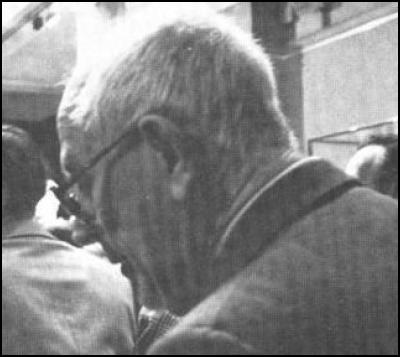
Bob Hecht - Photo: Now-defunct Connoisseur magazine
On August 27, 1991, Bob "the biggest dealer" Hecht, now on trial in Rome for antiquities trafficking, sent the following handwritten letter to Turkish journalist Ozgen Acar about their shared enthusiasm for ancient coins, among other subjects. I was mentioned, and since I'd been collaborating with Acar on antiquities stories for Connoisseur and The Economist, Acar faxed a copy of the letter to me from Turkey.
In the letter Hecht is still agitated about my mention of him in The Economist magazine in relation to the Hunt-Sotheby's auction of June 1990, where a fragmentary vase and wine cup signed by master Athenian artist Euphronios, and now contested, were on the block along with a hoard of coins. Many of the coins came from a trade with the Metropolitan Museum in the early 1970s.
Tom Hoving, the Met's director at the time, deaccessioned and sold the coins to partly finance the million dollar purchase from Hecht in 1972 of the "complete" Euphronios vase -- now about to be repatriated to Italy following recent negotiations between Italy and current Met director Phillipe de Montebello.
Hecht also sold the Euphronios fragmentary bowl and wine cup in the 1970s to Bruce McNall, who became his partner in the antiquities business on Rodeo Drive; McNall then sold the pieces to Bunker Hunt. McNall eventually went to jail for overvaluing coins.
When Sotheby's hammer came down on the same Euphronios wine cup in June 1990, the piece slipped into the hands of convicted antiquities smuggler Giacomo Medici, also a former partner of Hecht's, and the person believed to be the one Hecht first acquired the cup from in 1971 via a looted Etruscan tomb north of Rome.
To my complete surprise, some months after The Economist article appeared in which I mentioned Hecht, the then 71-year old antiquities legend retaliated by attempting to slug me at an art exhibition on Manhattan's Upper East Side, muttering "Why you. . ." I had been unfamiliar with his history as a bully up until then and have since learned about his fistfights as an undergraduate at Haverford College and at the American Academy in Rome, for instance.
In The Economist piece I refer to Hecht being apprehended in Turkey in the 1960s (Economist editors said "arrested") and declared persona non grata over some coins he was taking out of the country.
Brian Burrough cited the same incident in 1994 in Vanity Fair, describing Hecht being "detained " at the Istanbul airport, the coins confiscated and Hecht declared persona non grata with Hecht claiming he "intended to donate the coins to a Turkish museum". The VF article also noted Italian police "expressed interest" in Hecht's activities as early as 1950, that he was charged in Italy with antiquities trafficking in 1961 and asked to leave the country in 1963. But there was no formal order -- so Hecht returned to Italy until it got hot again in 1973 following his sale to the Met of the "complete" Euphronios.
At the time Hecht wrote to Acar, Ozgen and I were developing a feature piece for Connoisseur on Turkish antiquities dealer Aydin Dikmen, who's been arrested numerous times for looted art over the past 40 years, most recently in 1997 at his residence in Munich with a $40 million hoard of icons, frescoes and mosaics plastered inside the apartment walls.
Hecht's comment about me in the letter to Acar seemed designed to drive a wedge between me and Ozgen as payback for my targeting him in The Economist article and failing to abide by the silent rules of the game: Hands off -- regard him as an informed source:
Robert E. Hecht Jr.
15, boulevard de Salon Mauburg 75007 Paris
27 Aug. 1991Sevgili [Dear] Ozgen,
I thank you for the letter of August 22.
The dating of the coins at issue is fully discussed by Liselotte WEIDAUER, PROBLEME DER FRUMEREN ELEKTRON PRAGUNGEN (TYPOS II). They are pre-Croesus, but surely after 600 B.C.
When you say 7th century two level, what besides the coins dates the level?I am aware of Aydin Dikmen as a faker. I even heard that he once had an atelier where he made fakes (dangerous ones) and completed fragmentary ancient objects. I did not tell you that the Sumerian Statue of de Menil came from him. As a matter of fact, I assumed that it & other "Sumerian" fakes were made in Syria & Lebanon. Also, the rumors that I have heard regarding the fake dikite stones [animal figures] are that they were produced locally in the Van region.
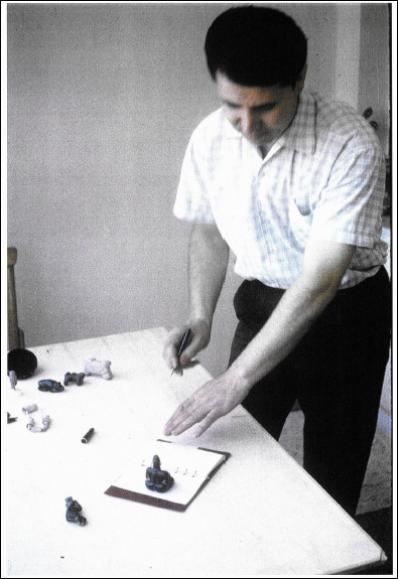
Aydin Dikmen & the dickites - Photo Credit: Patricia Connor
[See also… Getting To The Bottom Of The Dorak Affair ]
I am surprised to hear that he [Dikmen] managed to sell the Andreas and get away with it.
[The Andreas reference is to the priceless early Christian mosaic of St. Andrew that was looted from the apse of Panagia Kanakaria, a church in north Cyprus. It is still missing, according to Dutch art dealer Michel van Rijn, who negotiated with Dikmen and Indianapolis dealer Peg Goldberg for the piece. Dikmen also produced a fake mosaic of St. Andrew that Cypriot antiquities authorities took possession of via van Rijn. The highly publicized 1989 trial of Cyprus vs. Goldberg & Feldman resulted in the return to Cyprus of the Kanakaria mosaics of Matthew, James, an adolescent Christ -- and the North Archangel, which Goldberg described as giving off a "white light"; she repeatedly told interviewers, "It was like I'd always known him".]
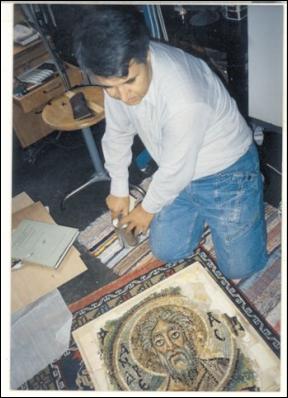
Aydin Dikmen on his knees with the genuine St. Andrew
Photo Credit: Michel van Rijn
Sincerely B P.S. I know nothing about
Coin World. Why not the N.Y. Times Magazine? How does justice work?
This is something stolen -- plundered! Yet no one lifts a
finger. It is also rumored that he traffics in antiquities
(& other things) & is never bothered. That you bring this
scoundrel before the eyes of the public is rather
praiseworthy, but don't spoil a good thing by inaccuracies
-- or downright lies like your friend Susan Masur
[sic] writes.
The better
preserved coins of the lion/bull back to back & the 2 youths
would probably go around 150,000 S.Frs. each at auction.
The poorest one about 10,000 S.Frs. But one never
knows.
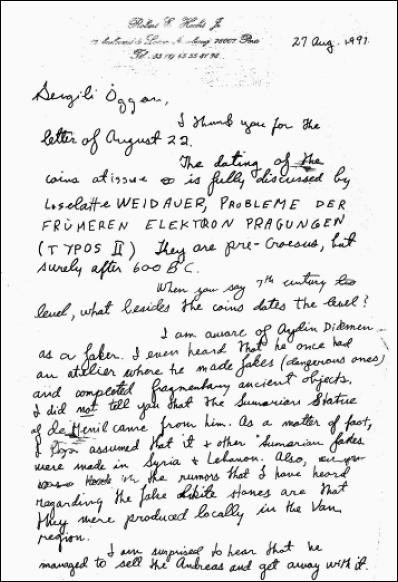
Click for full letter - .pdf format 2 Pages
Fast-forwarding to 2005 -- Hecht's comments about Dikmen look tongue-in-cheek to say the least, following the seizure by Paris police of Hecht's memoirs in 2001 and now his indictment and current trial in Rome on antiquities smuggling charges.
Hecht is accused of trafficking 94 items, according to the list of antiquities sent to me by Maurizio Fiorilli, lawyer for the state of Italy in the case against Hecht and former Getty museum curator Marion True. Fiorelli told me by phone from Rome last week that Hecht has now said he will appear to address charges in mid-January or the first week in February 2006.
Fiorilli also said he laments the media not covering the case with a greater detailed understanding, implying that the trial serves to highlight the urgency of saving what shards are left of our human past and the planet's history (for every pot illegally excavated countless numbers are destroyed).
Following is Italy's list of antiquities allegedly trafficked by Hecht and True.
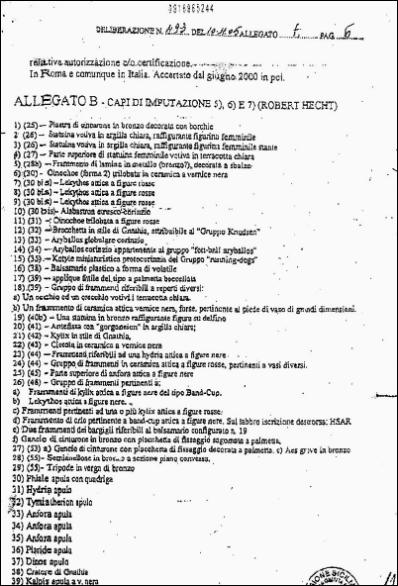
Click for full letter - .pdf format 3 Pages
 Suzan
Mazur's stories on art and antiquities have been published
in The Economist, Financial Times, Connoisseur, Archaeology
(cover) and Newsday. Some of her other reports have
appeared on PBS, CBC and MBC. She has been a guest on
McLaughlin, Charlie Rose and various Fox television news
programs. Email:
sznmzr@aol.com
Suzan
Mazur's stories on art and antiquities have been published
in The Economist, Financial Times, Connoisseur, Archaeology
(cover) and Newsday. Some of her other reports have
appeared on PBS, CBC and MBC. She has been a guest on
McLaughlin, Charlie Rose and various Fox television news
programs. Email:
sznmzr@aol.com


 Binoy Kampmark: Gender Stunts In Space - Blue Origin’s Female Celebrity Envoys
Binoy Kampmark: Gender Stunts In Space - Blue Origin’s Female Celebrity Envoys Richard S. Ehrlich: A Deadly Earthquake & Chinese Construction
Richard S. Ehrlich: A Deadly Earthquake & Chinese Construction Ian Powell: It Does Matter To Patients Whether They Are Operated In A Public Or Private Hospital
Ian Powell: It Does Matter To Patients Whether They Are Operated In A Public Or Private Hospital Gordon Campbell: On Marketing The Military Threat Posed By China
Gordon Campbell: On Marketing The Military Threat Posed By China Binoy Kampmark: Olfactive Implications - Perfume, Power And Emmanuel Macron
Binoy Kampmark: Olfactive Implications - Perfume, Power And Emmanuel Macron Martin LeFevre - Meditations: True Abundance
Martin LeFevre - Meditations: True Abundance